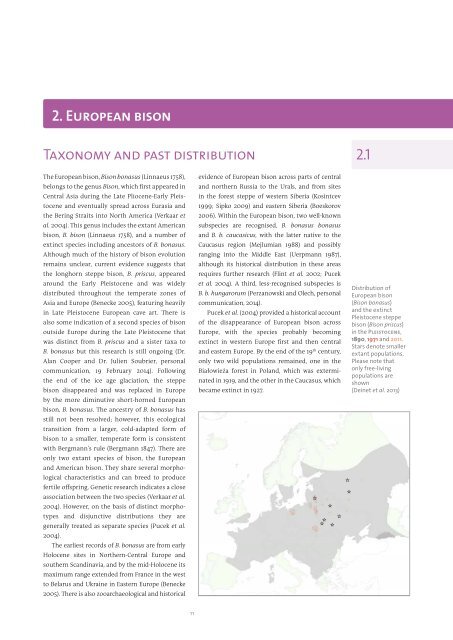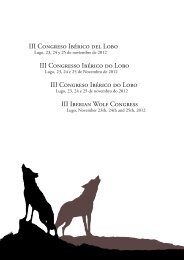Bison-Rewilding-Plan-2014
Bison-Rewilding-Plan-2014
Bison-Rewilding-Plan-2014
- No tags were found...
Create successful ePaper yourself
Turn your PDF publications into a flip-book with our unique Google optimized e-Paper software.
2. European bisonTaxonomy and past distribution2.1The European bison, <strong>Bison</strong> bonasus (Linnaeus 1758),belongs to the genus <strong>Bison</strong>, which first appeared inCentral Asia during the Late Pliocene-Early Pleistoceneand eventually spread across Eurasia andthe Bering Straits into North America (Verkaar etal. 2004). This genus includes the extant Americanbison, B. bison (Linnaeus 1758), and a number ofextinct species including ancestors of B. bonasus.Although much of the history of bison evolutionremains unclear, current evidence suggests thatthe longhorn steppe bison, B. priscus, appearedaround the Early Pleistocene and was widelydistributed throughout the temperate zones ofAsia and Europe (Benecke 2005), featuring heavilyin Late Pleistocene European cave art. There isalso some indication of a second species of bisonoutside Europe during the Late Pleistocene thatwas distinct from B. priscus and a sister taxa toB. bonasus but this research is still ongoing (Dr.Alan Cooper and Dr. Julien Soubrier, personalcommunication, 19 February <strong>2014</strong>). Followingthe end of the ice age glaciation, the steppebison disappeared and was replaced in Europeby the more diminutive short-horned Europeanbison, B. bonasus. The ancestry of B. bonasus hasstill not been resolved; however, this ecologicaltransition from a larger, cold-adapted form ofbison to a smaller, temperate form is consistentwith Bergmann’s rule (Bergmann 1847). There areonly two extant species of bison, the Europeanand American bison. They share several morphologicalcharacteristics and can breed to producefertile offspring. Genetic research indicates a closeassociation between the two species (Verkaar et al.2004). However, on the basis of distinct morphotypesand disjunctive distributions they aregenerally treated as separate species (Pucek et al.2004).The earliest records of B. bonasus are from earlyHolocene sites in Northern-Central Europe andsouthern Scandinavia, and by the mid-Holocene itsmaximum range extended from France in the westto Belarus and Ukraine in Eastern Europe (Benecke2005). There is also zooarchaeological and historicalevidence of European bison across parts of centraland northern Russia to the Urals, and from sitesin the forest steppe of western Siberia (Kosintcev1999; Sipko 2009) and eastern Siberia (Boeskorov2006). Within the European bison, two well-knownsubspecies are recognised, B. bonasus bonasusand B. b. caucasicus, with the latter native to theCaucasus region (Mejlumian 1988) and possiblyranging into the Middle East (Uerpmann 1987),although its historical distribution in these areasrequires further research (Flint et al. 2002; Puceket al. 2004). A third, less-recognised subspecies isB. b. hungarorum (Perzanowski and Olech, personalcommunication, <strong>2014</strong>).Pucek et al. (2004) provided a historical accountof the disappearance of European bison acrossEurope, with the species probably becomingextinct in western Europe first and then centraland eastern Europe. By the end of the 19 th century,only two wild populations remained, one in theBiałowieża forest in Poland, which was exterminatedin 1919, and the other in the Caucasus, whichbecame extinct in 1927.________Distribution ofEuropean bison(<strong>Bison</strong> bonasus)and the extinctPleistocene steppebison (<strong>Bison</strong> priscus)in the Pleistocene,1890, 1971 and 2011.Stars denote smallerextant populations.Please note thatonly free-livingpopulations areshown(Deinet et al. 2013)11



